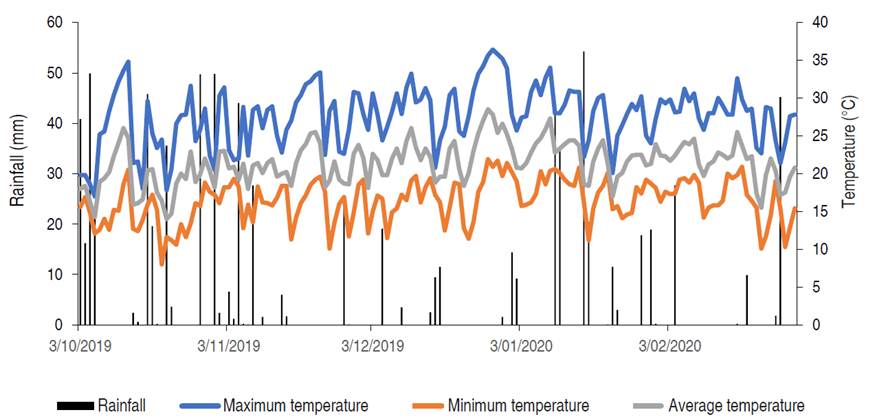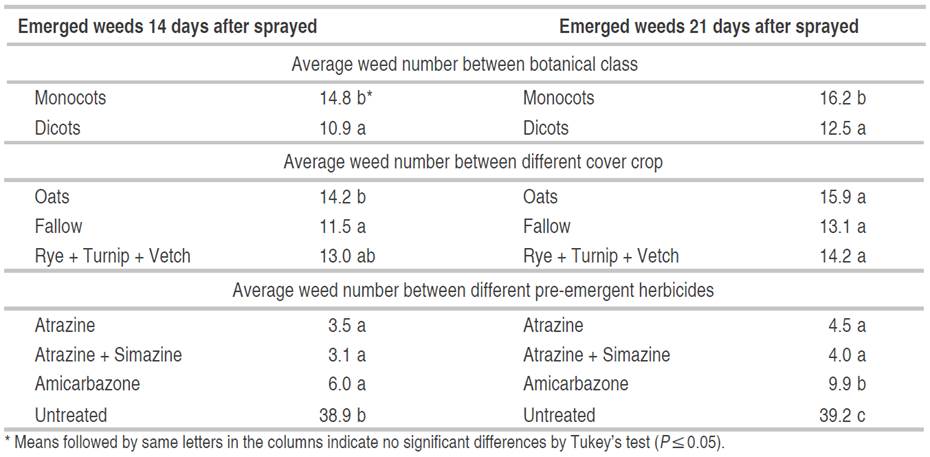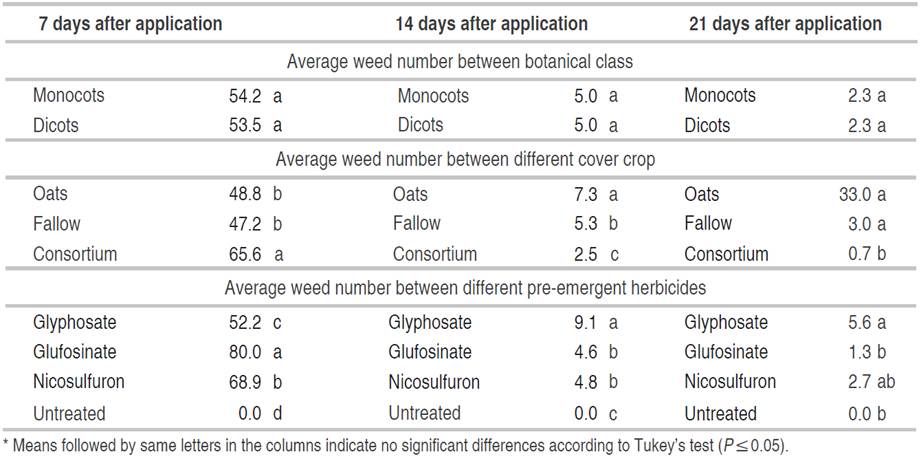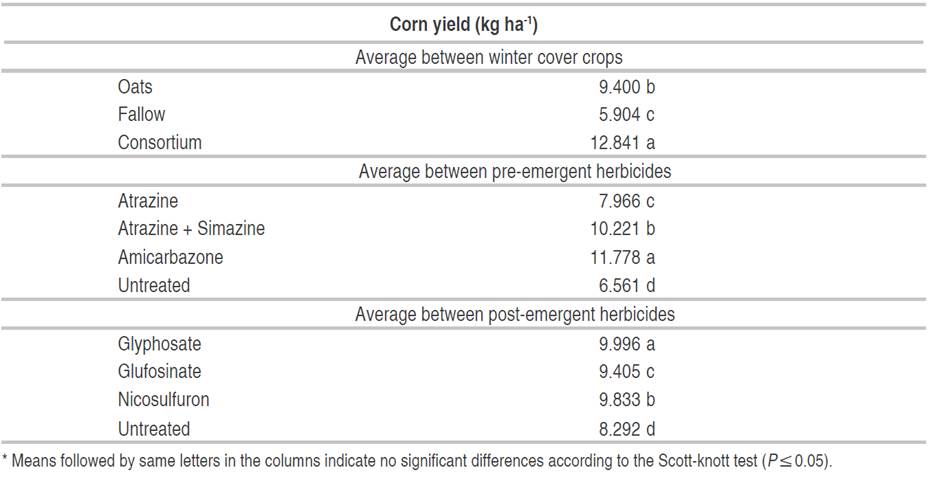No-till system is considered the most widely and sustainable practice for agricultural production in the Brazilian agroecosystems (Fuentes-Llanillo et al., 2021). One of the premises of this management is the rotation of cash and cover crops, maintaining the soil constantly covered, using the alternation of different crops in the same area. Therefore, the same species return to the same location, following the interval occupied by other crops. In contrast, agricultural systems based on crop succession result in low biomass production that keeps the soil uncultivated during specific periods of the year, promoting degradation, the presence of problematic weeds species, leading the systems to be less efficient and unsustainable due to increased costs, yield stagnation, and the evolution of weed resistance species (Barbieri et al., 2019; Adami et al., 2020).
From this conceptualization, the sustainability of the farm system involves integrated management tools, in which cover crops preceding major crops, in isolated or in a consortium can bring numerous benefits to the production system (São Miguel et al., 2018). The use of cover crop mixtures promoted a beneficial intraspecific competition to the system, making a physical barrier by the straw that reduces the amount and quality of light, the wavelength of waves, and the thermal amplitude that reaches the soil, which are the most stimulating environmental factors to overcome dormancy by weeds (Gomes and Christoffoleti, 2008). Additionally, there is a reduction in the stimulation of germination processes and in weed growth, which presents propagules with low seed reserve (Brighenti and Oliveira, 2011).
Complementary, the use of different chemical management strategies in the control of weed species, in which the rotation between mechanisms of action and the use of pre-emergent herbicides provide effective results and turns into an indispensable tool. This integrated management promotes efficient weed control, with the aim of controlling populations at the beginning of their development and exploring the residual herbicide effect in order to keep the crop out of competition during the critical period of infestation, ensuring raising success in productivity (Galon et al., 2018). Also, previous research has found that the weed control stage to reduce greater than 5% yield loss in corn, must be before 11 cm height and before 27 days after corn emergence, highlighting the relevance of effective early weed control (Soltani et al., 2022). Thus, the need for integrated tools for the management of agricultural production systems justifies the realization of related studies, which can help professionals and farmers increase adaptation for sustainability and profitability work. In this context, this study aimed to evaluate the influence of different cover crops in dry mass accumulation, its impacts on weed population, and the effects on corn crop yield. Besides, the use of different pre-and post-emergent herbicides on corn, to evaluate weed control, crop selectivity, and crop yield.
MATERIALS AND METHODS
General description. The experiment was performed in Sertão/RS - Brazil (28°03'18" S and 52°14'53" W), at 670 masl. The climate of the region according to the Köppen classification is "Cfa", with 17.8 °C average annual temperature and 1.791 mm of average annual rainfall. The soil of the site is classified as Deep Dystrophic Red Nitossol, with 49% of clay and 2.2% of organic matter, according to soil collection and analyses shown in Table 1.
Experimental design. The experimental arrangement was randomized blocks with four replications, using three winter covers × four pre-emergence herbicides × four post-emergence herbicides in corn, totaling 192 experimental plots. The cover crop treatments used during the winter were fallow; black oats (Avena strigosa L.) with a density of 350 plants m-2 and; crop mixure using rye (Secale cereale L.) + vetch (Vicia sativa L.) + turnip (Raphanus sativus L.) in 210 plants m-2 of rye + 60 plants m-2 of vetch + 50 plants m-2 turnip that means 60% - 20% - 20% of the recommended number of plants from each species, respectively. These cover crop species were chosen based on regional adoption by farmers and their strong performance in cover crop use.
Each experimental plot was 5 m long and 3.5 m wide, with seven corn rows spaced 0.45 m between them. Within each unit, the evaluated area was organized into plots with an area of 5.4 m2, 4 m in length, and three central rows of corn, to remove possible border effects. The cover crop treatments were sown with a seeding/fertilizer (Semeato® 15/17), with 17 seed lines spaced 0.17 m between them. For corn sown, was used the sower/fertilizer Kuhn® PG PLUS 700, with seven seed lines spaced 0.45 m between them. The corn hybrid used was the Pioneer® P3565PWU, with Agrisure Viptera, Powercore Ultra, Herculex 1, Liberty Link®, and Roundup Ready® 2, with a final population of 7 plants m-2. Fertilization was performed according to the recommendations of the Brazilian Society of Soil (2004).
The pre-emergent herbicides used on corn were non treated; atrazine (2.5 kg a.i. ha-1); atrazine + simazine (1.625 + 1.625 kg a.i. ha-1) and; amicarbazone (0.14 kg a.i. ha-1). The post-emergent herbicides on corn were non treated; glyphosate (1.92 kg a.i. ha-1); ammonium glufosinate (0.4 kg a.i. ha-1) and; nicosulfuron (0.08 kg a.i. ha-1).
Sample collection and evaluations during cover crop period. The dry mass of the cover crops was determined within a square of 0.5 × 0.5 m. These samples were collected in each plot 30 days before corn was planted and harvested at the soil level. The weed number was counted on the same day. The cover crop samples were placed in an oven at 65 °C until a constant mass was obtained. The dry mass for each plot was weighed and the weed number was used for the statistical analysis in each cover crop treatment.
To eradicate the cover crop, glyphosate (1.92 kg a.i. ha-1) was sprayed and 12 days after the first application, paraquat (0.4 kg a.i. ha-1) was used. The application of all herbicide treatments was performed with a backpack sprayer pressurized by CO2, using the spraying nozzle model TeeJet XR110015 spaced 0.5 m between them, at 3.0 bar, at a constant velocity, and a volumetric flow of 180 L ha-1.
Corn crop details. The amicarbazone treatment was applied on September 30th, 2019, 11 days before corn was sown, according to the recommendations. Right after sown was planted on October 11th, 2019, the others pre-emergence treatments were sprayed. Post-emergence treatments were sprayed when the crop was between V3-V4 vegetative state, according to herbicide recommendation.
Weed number and corn injuries rates were collected at 7 and 14 days after crop emergence (DAE), which means 14 and 21 days after herbicide application (DAA). The visual control effect on weeds and the injuries on corn from post-emergent herbicides were performed at 7, 14, 21, 28, and 35 DAA. To evaluate these injuries and weed control, the percentage scores were used, being zero the absence of weed control or injuries in crop and a score of 100 means the total weed control or complete death of corn plants. All crop management was performed as needed during the life cycle, expecting higher yields. The corn was harvested manually; grains were weight and then moisture was determined. Results were expressed in kg.ha-1.
Statistical analysis. The data obtained were verified regarding the homogeneity of variance and subsequently submitted to variance analysis (P≤0.05), using the software ASSISTAT 7.7 BETA (Silva and Azevedo, 2016). A significant effect was verified by the evaluated parameters, and the means were compared using the Scott-Knott cluster test (P≤0.05) for dry mass production, the number of weeds in the winter period, and corn yield. For weed number during the corn season and herbicides injury Tukey’s test was used (P≤0.05).
RESULTS AND DISCUSSION
Dry matter and weeds in the winter period. Regarding the dry mass in the fallow, the production was mainly originated from weeds that emerged during the winter, predominantly ryegrass (Lolium multiflorum L.) (Table 2). This treatment showed high variation in density and weed flow, producing low dry mass, even when samples with a high number of plants m-2 were collected, indicating a higher variation. In some plots, more than 100 plants m-2 were counted, demonstrating the high germination rate of this species that are widely present in the seed bank mainly in southern Brazil.
Table 2 Dry mass production and weed number at each cover crop treatment during winter season. SERTÃO/RS, 2020.

The predominance of ryegrass is related to its highly competitive ability, adaptation, easy dispersal, natural dryness, and few control alternatives due to resistance to EPSPS, ALS, and ACCase herbicides, making it a troublesome and also increasing herbicide costs with above 57% (Tironi et al., 2014; Vargas et al., 2015). When managed properly, ryegrass can be a crop favorable to corn in its succession. However, when it is a weed, it can produce less dry mass, compromising the development and productivity of corn through competition and the release of allelochemical compounds (Franz et al., 2020; Moraes et al., 2013).
Several other weed species at different growth stages were observed in the area without crop in winter. This scenario makes weed management more challenging, and also the lack of crops inadequately protects the soil during this season. In the treatments with oats and the crop mixture, the implementation with seeders ensures uniform plant growth above the soil and increases mass production, which improves the sustainability of the system and the easy use of herbicides, reducing the infestation of weeds and improving the yield of subsequent crops (Martins et al., 2016).
The establishment of oats and the crop mixture was carried out by the sower, which stimulated the growth of weed species in the sowing line, where soil tillage took place. Nevertheless, no significant subsequent flows were observed, possibly due to the rapid closing of the space between rows and homogeneous coverage of the area, presenting a number of weeds inversely proportional to the speed with which the vegetation cover could cover the ground and the ability to increase above ground mass production. Likewise, it was observed that the dry mass production capacity in intercropping was significantly higher, which is in agreement with previous research that concluded that farmers can potentially add the intercropping pattern to their crop systems to maximize the functions provided by cover crops (Bybee‐Finley et al., 2022).
Weed control. It is known that the soil dynamics of pre-emergent herbicides are highly dependent on the edaphoclimatic conditions to which they are subjected. Precipitation of about 20 mm is critical for the herbicide to transpose the dry mass layer and be active in soil solution (Maciel and Velini, 2005). Moreover, there is a positive correlation between rainfall and the leaching of herbicide molecules, which may compromise the herbicide’s effect on target plants when they are in high volume (Monquero et al., 2008). Corn sowing and pre-emergence spraying were performed on the same day during October, with elevated rainfall and temperatures that year (Figure 1). These climatic conditions were favorable for the rapid emergence of crops and weeds. The weed number during the corn crop is provided in Table 3.

Figure 1 Precipitation, average, maximum and minimum temperature during corn season in SERTÃO/RS, 2020.
Regarding the winter cover crop treatments, at 7 DAE, or 14 DAA, the emerged weed number was higher in the presence of cover crop, compared to the fallow. It is assumed that the absence of crop remains and the moisture in the soil allowed a faster action of the herbicide in the soil solution since the aerial mass continues to be a physical barrier for almost pre-emergent herbicides (Matos et al., 2016). However, after the herbicide reaches the soil, usually by rain, the remaining crop layer promotes further distribution and persistence of the herbicide in the soil, due to the channels formed between remaining plants and soil microorganisms and, mainly, by the protection of degradation processes to which the herbicide molecule is vulnerable when it is outside of crop residues (Sorenson et al., 1991).
In the subsequent evaluation (21 DAA), it was observed that all winter treatments were similar when related to weed number. In relation to the herbicides used in corn post-emergence, atrazine and atrazine + simazine treatments achieved great control of weeds (Table 4). Previous research showed that the interception of the herbicide amicarbazone by straw, and its transposition before precipitation occurs, may suffer several modifications (Cavenaghi et al., 2007). The weed number from the non-herbicide sprayed treatment indicates the relevance of pre-emergent herbicides management in corn, regardless of the cover crop presence before, since, from 11 DAE, the crop already is affected by weed interference (Galon et al., 2008).
No crop injuries were observed (data not provided), which demonstrates the selectivity of these herbicides, which supports their widespread use during corn cultivation. The ammonium glufosinate had the best performance on weed control at 7 DAA, presenting an average control of around 80%. Rapid chlorosis of the treated tissue, followed by necrosis and death of plants after a few days caused by the herbicide actions on the target plants, was responsible for the high level of damage observed (Brunharo et al., 2014). After 21 DAA, the growth of plants that were in the initial stage of development and were shaded by taller plants that received the herbicide application, resulted in a drastic decrease in injuries according to visual evaluations, justifying the non-presentation of these additional data, once these weeds did not show injuries and the visual data was approximately 0% of phytotoxicity.
In relation to post-emergence herbicides treatments, glyphosate promoted fewer symptoms in weeds in the first evaluation at 7 DAA, which may result from its action mode demonstrating slow control, allied to the presence of resistance weeds species, events that have become widespread after Round Ready® technology (Brunharo et al., 2014; Heap and Duke, 2018). Nonetheless, the herbicide effects were longer-lasting, presenting injuries in weeds until the evaluation of 21 DAA.
Intercropping pattern improves weed control. It seems a good alternative since besides enabling a higher biomass production and providing benefits related to soil conservation, helps in moisture maintenance and nutrient cycling and also decreases weed number. It does this by increasing herbicides efficacy and biological decomposition activity, as well as the decomposition of weed seeds present in the soil bank, and by providing a physical barrier that prevents the stimulation of emergence, especially in weed species with positive photoblastic characteristics (Chu et al., 2017; Chahal and Van Eerd, 2018; Ottavini et al., 2019).
Grain yield. Cover crop use before cash crop had positive influence on grain yield. The higher productivity was obtained after intercrop use, followed by oats, presenting 12900 kg ha-1 and 9350 kg ha-1, respectively (Table 5). The fallow had a reduction of more than 50% in corn productivity in relation to the crop consortium. These results are related to the organic material added to the system by the winter crop, which influences the dynamics of soil moisture and its use by the crop; in addition to promoting a mechanical and thermal barrier to the soil, providing better moisture conservation and reducing evapotranspiration losses concerning the uncovered soil (Gava et al., 2013; Klein and Klein, 2015; Barbieri et al., 2020).
Regarding the pre-and post-emergent herbicides used and the interaction with the corn yield, the amicarbazone and glyphosate treatments resulted in higher grain yields, respectively. Satisfactory results in weed control have been found with the use of the herbicide amicarbazone by Ferreira et al., (2020). However, the use of this herbicide in relation to its residual and carryover potential in succession crops should be considered, depending on the used rate (Alonso et al., 2011). The performance of glyphosate demonstrates that despite its reduced efficiency in current weed populations, when it is used following correctly vegetative stage and rate, it demonstrated satisfactory results in weed control.
CONCLUSIONS
The intercropping pattern promoted higher biomass accumulation, decreased weed number, and improved corn productivity. Atrazine and atrazine + simazine treatments had the greatest reduction in the weed number used by pre-emergence herbicide, and the ammonium glufosinate provided the highest levels of control in post-emergence corn. The treatments amicarbazone and glyphosate obtained the best performances in relation to crop yield when used during pre-and post-emergence, respectively.



















